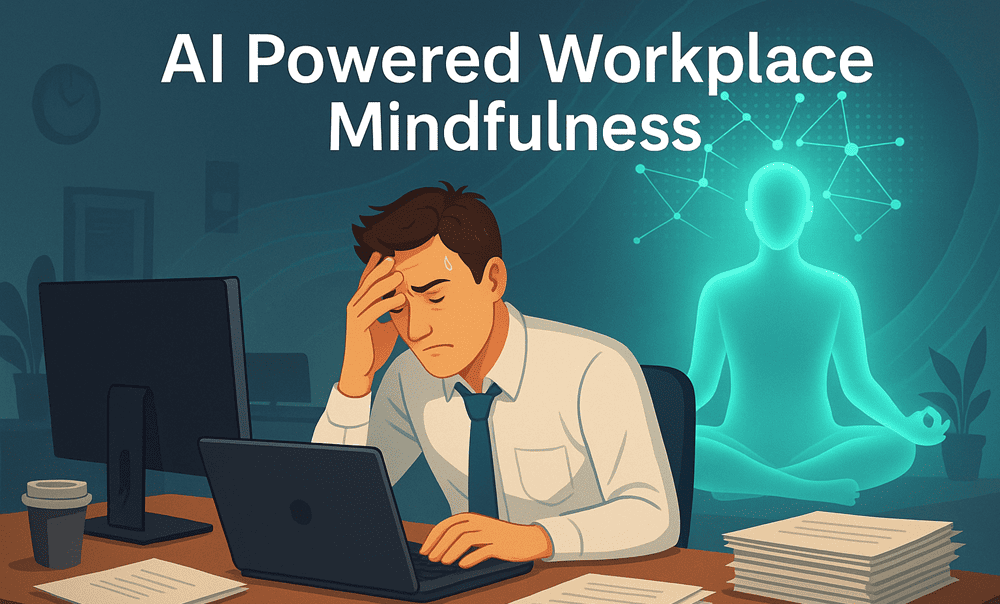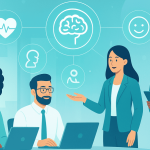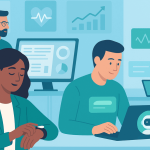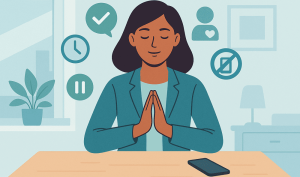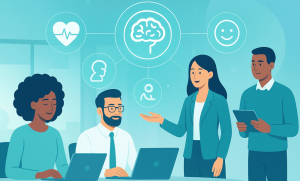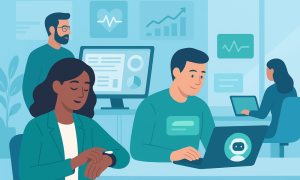Modern workplaces are evolving, and employee well-being isn’t just a buzzword—it’s a priority. Workplace mindfulness can transform stress-filled environments into spaces of calm, focus, and improved mental health. In this post, we discuss how integrating AI-powered tools into daily routines enhances workplace mindfulness, supports wellbeing meditation, and showcases why AI for employee mental health is more than a trend—it’s a transformation.
1. Why Workplace Mindfulness Matters
Workplace mindfulness refers to paying attention to the present moment, without judgment, within a work context. It boosts:
- 👁️ Focus: Mindful awareness cuts through distractions.
- 💬 Communication: Mindfulness fosters empathy and clear dialogue.
- 🧠 Stress Resistance: Being in tune with thoughts allows better emotional regulation.
- 🌱 Resilience: Employees bounce back faster from setbacks.
Industry Insight: A study by the American Psychological Association found that organizations with mindfulness programs saw a 23% increase in employee engagement and a 31% decrease in stress reports.
Case in Point: Tech firm ByteWave implemented short mindfulness breaks before team meetings. They observed a 17% drop in deadline-related stress.
2. The Intersection of AI and Mindfulness
AI for wellbeing now plays a pivotal role in personalizing mindfulness practices:
a. Customized Break Reminders
AI tools learn each individual’s work rhythm when they’re most productive and when they need a pause. They then suggest timely mindfulness or wellbeing meditation breaks.
b. Mood-Sensitive Check‑ins
Using sentiment analysis in chat or email, AI systems can gauge stress levels. These check-ins can trigger invitations to breathing exercises or reflection prompts.
c. Guided Meditation & Micro‑sessions
AI curates short, guided sessions tailored for different times of the day like quick, energizing pauses in the morning or calming breaths before wrapping up tasks.
3. AI Tools That Support Workplace Mindfulness
Here’s a comparison table to help you visualize how different AI-driven apps support daily mindfulness:
| Feature | CalmlyAI™ | Wellbeing Navigator | MindfulPulse AI |
| Smart Break Prompts | ✓ | ✓ | ✗ |
| Mood Detection | ✗ | ✓ | ✓ |
| Guided Meditation Library | 50+ sessions | 50+ sessions | 20+ sessions |
| Team Stats Dashboard | ✓ | ✓ | ✓ |
| Pricing (per user/month) | $8 | Custom | $4 |
| API Integration | Popular tools (Slack, Teams) | Popular tools, Email+Calendar | Slack only |
These tools make it easier for managers to track team well-being without compromising confidentiality.
4. Crafting a Daily AI‑Guided Mindfulness Routine
Mindfulness becomes more manageable when guided by intelligent support. Here’s how you can weave AI into your day-to-day practice for lasting wellbeing.
Step 1: Morning Start
- Begin your workday with a 2‑minute guided posture and breathing check.
- Let AI suggest a short wellbeing meditation to prep for the day’s tasks.
Step 2: Scheduled Interventions
- Around mid-morning and mid-afternoon, AI prompts you to pause. Even a brief, 60-second pause can reset focus.
- Use voice- or screen-free techniques; AI monitors your response pattern and adjusts future prompts.
Step 3: Peer‑based Mindful Check‑ins
- AI identifies times when a team “check-in” is due—particularly under stress.
- These use simple questions like “How’s your energy?” and suggest a micro-practice or group breathing session if needed.
Step 4: End‑of‑Day Reflection
- Use AI-facilitated surveys or voice journals to reflect—“What energizes me?” or “What drained me?”
- Over time, trends in energy and mood guide scheduled mindfulness practices.
5. Benefits for Employee Mental Health
Implementing AI-powered mindfulness tools delivers clear benefits:
- Reduced Absenteeism
- Workers with AI-guided mindfulness took 30% fewer mental health days (TechWell survey, 2024).
- Workers with AI-guided mindfulness took 30% fewer mental health days (TechWell survey, 2024).
- Improved Focus & Productivity
- 72% of participants reported sustaining attention longer during deep tasks (MindMetrics, Q3 2024).
- 72% of participants reported sustaining attention longer during deep tasks (MindMetrics, Q3 2024).
- Enhanced Emotional Intelligence
- Regular mindfulness delivery increases empathy scores in annual reviews by 14%.
- Regular mindfulness delivery increases empathy scores in annual reviews by 14%.
- Lower Burnout Risk
- Proactive micro-breaks interrupt prolonged pressure cycles, reducing reported burnout by 25%.
- Proactive micro-breaks interrupt prolonged pressure cycles, reducing reported burnout by 25%.
6. Integrating AI for Employee Mental Health
AI’s potential extends beyond mindfulness prompts:
- Risk Identification: AI flags repeated stress patterns indicates deeper issues. This allows timely manager or coaching team interventions.
- Content Delivery: It offers curated wellness modules—like mindful productivity, stress resilience, or sleep hygiene—based on individual preferences.
- Data‑driven Management: In aggregate, AI compares groups over time—throwing up insights like “Team A shows steady improvement in calmness score over 8 weeks.”
By combining AI for employee mental health with day-to-day mindfulness, companies create a proactive wellness environment.
7. Spotlights from Real Companies
- PayFlux Financial introduced AI-led sessions on breathing while trading. Turnover rates dropped 8%, and compliance errors fell.
- HealthHive IT offered short “reset” breathing breaks during high-pressure development sprints. They report a 30% dip in post-sprint stress levels.
- EduNext uses AI to suggest guided meditations in mid-semester crunches—student outcomes improved, and teacher satisfaction climbed.
8. Supporting Wellness Beyond Mindfulness
AI integrations support more than just mindfulness:
- Sleep‑Aware Nudges
High-stress individuals receive evening routines—like winding down with meditation before bed. - Persistent Anxiety Tracking
Patterns from micro-check-ins might reveal signs of lasting anxiety. These are referred for deeper support, such as AI for anxiety relief tools. - Role‑based Coaching
Specific job roles—customer-support vs. engineering—get practical mindfulness aids relevant to their stress triggers.
9. Implementing This at Your Organization
✅ Pilot & Learn
Start small—one team or department—for 6–8 weeks.
📊 Measure Data
Track engagement, energy reports, stress surveys, absenteeism, and task focus.
📏 Scale Smartly
Offer chosen tools across teams, tailor prompts to business cycles (e.g. quarterly reviews, product launches).
🤝 Blend with Human Support
AI offers data and suggestions—combine with human coaching, counseling, or peer check-ins for maximum effect.
10. Tips for Optimal Adoption
- Choose user-friendly AI: Opt for easy setup and minimal friction.
- Be transparent: Explain how data is used and protect privacy.
- Promote flexibility: Encourage staff to adapt prompts or practice sessions.
- Leverage peer influence: Highlight team leaders embracing mindfulness.
11. Summary Table
| Benefit | What AI Brings |
| Timely mindfulness breaks | Custom break suggestions based on work patterns |
| Improved mental health | Mood check-ins and micro‑practice nudges |
| Data‑informed support | Spotting anxiety trends and offering AI for anxiety relief |
| Sustained performance | Regular reset points maintain focus and energy |
By embedding these AI-enhanced habits, organizations create space for employees to thrive mentally and perform optimally.
“When teams learn to pause and breathe—not only find clarity—they build a culture that values balance.”
— Dr. Karen Liu, Workplace Psychologist
Final Thoughts
Workplace mindfulness powered by AI isn’t futuristic—it’s practical. From wellbeing meditation to personalized check-ins and scalable insights from AI for employee mental health, companies can foster sustained well-being.
As mental health continues to shape work culture, integrating these tools becomes a smart investment—for individuals and the organization. If you’ve explored AI tools around AI for IT wellness or watched how AI for anxiety relief supports employees, consider adding mindfulness routines next.
Let Wellbeing Navigator guide you in crafting that next-level program—where every breath counts.
Want a free demo or case study on AI-driven workforce well-being? Reach out to learn how Wellbeing Navigator can support your team.

